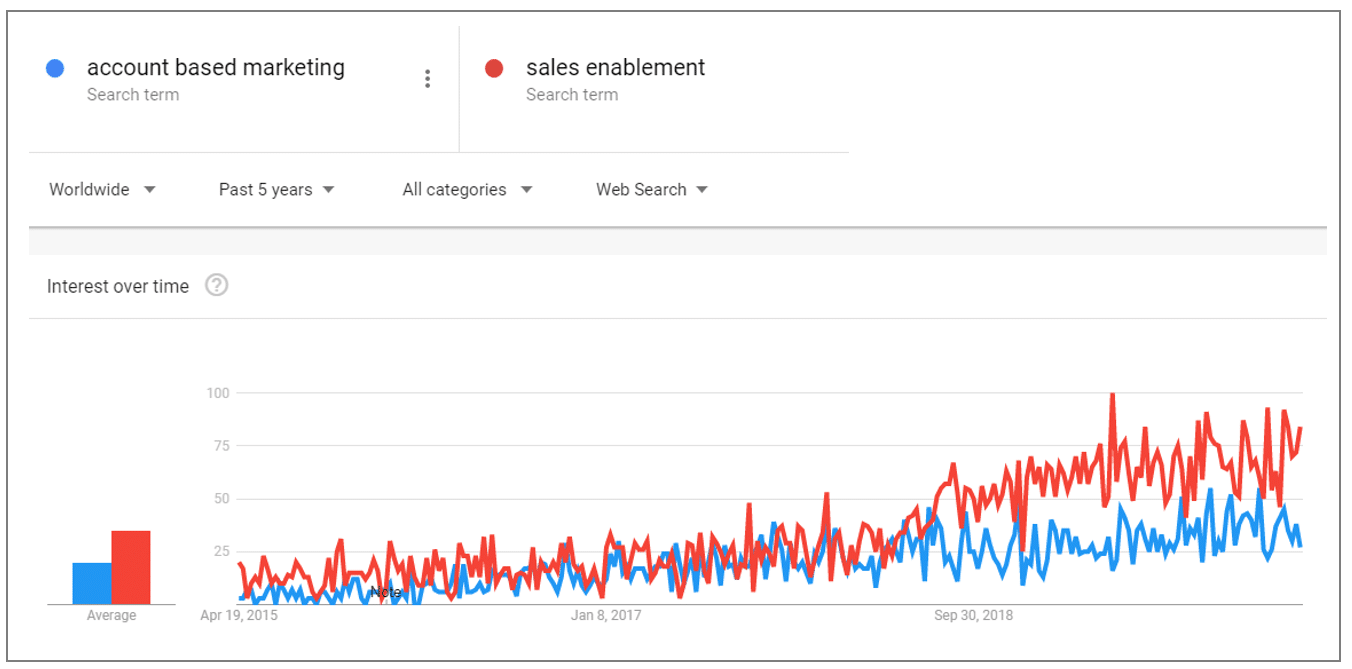Even before the coronavirus brought the global economy to a virtual halt, the way B2B businesses have been growing and nurturing new accounts was changing, particularly in the SaaS space.
The traditional focus on generating a high quantity of leads via widely targeted campaigns is not only inefficient, it’s poorly aligned with how B2B buyers search for new solutions.
Sales and marketing teams are already overwhelmed with a surplus of tasks, data, and campaigns, so sifting through large quantities of unqualified leads is an added (and unnecessary) burden.
This approach, at its best, is inefficient. At worst, it’s a tremendous drain on resources and money because it focuses your efforts on vanity metrics (e.g., the total number of traffic, leads, and conversions) instead of identifying the people and accounts that are most likely to close.
The key to unlocking these top tier accounts already lies with your sales and marketing teams and can be accessed from the CRM data you already collect. How each team communicates with each other is crucial for the success of identifying and closing new deals as well as expanding opportunities with existing customers.
When sales and marketing are aligned, real growth happens.
In this post, we’ll unpack exactly what we mean by sales and marketing alignment in the context of B2B marketing. We’ll also provide some tips on how you can get started with this approach using your existing resources (as well as a few tools that can help facilitate the alignment of sales and marketing teams across your organization).
Account-based marketing + B2B sales enablement = growth
There is no shortage of buzzwords in the B2B marketing space, but two terms, in particular, have risen to the top of the list—account-based marketing (ABM) and sales enablement. Both terms have gained traction over the last five years because they represent a shift in the way B2B marketing and sales teams are successfully growing their businesses.
The following chart from Google Trends demonstrates a steady increase of global searches for the terms “account-based marketing” and “sales enablement” over the past five years.

It’s helpful to define each of these terms prior to delving into the details about how an account-focused strategy can benefit your organization.
Account-based Marketing (ABM)
Account-based marketing is a strategic approach to B2B marketing and sales that focuses on targeting (and reaching out) to in-market accounts rather than individuals. The term was coined in 2004 by business management consultancy ITSMA, but the approach has been deployed in one way or another since the early nineties.
Sales Enablement
HubSpot defines sales enablement as, “the iterative process of providing your business’s sales team with the resources they need to close more deals. These resources may include content, tools, knowledge, and information to effectively sell your product or service to customers.”
Combining ABM with Sales Enablement
In a perfect B2B marketing world, ABM and sales enablement would be combined to describe a single approach – perhaps something like “growth alignment” (e.g., the alignment of sales and marketing as the foundation for business growth).
Why sales must talk to marketing and vice versa
The average B2B buyer consumes about 13 pieces of content prior to making a purchase decision. Most B2B companies have buying teams, so each person on the team typically reviews more than ten pieces of content from both first- and third-party sources. A Gartner article published last month outlines some characteristics of modern B2B buyers as follows:
- Customer satisfaction does not drive account growth. A customer’s need for new technology, organizational change, or expanded solutions is what drives growth.
- The complexity involved in introducing a new tool or solution can kill the sale. Complex tools tend to require significant organizational change, which can be daunting).
- Customers’ confidence in their ability to make the right decision when evaluating a new tool is key to making the sale. Customer decision confidence makes a high-quality account growth purchase nearly 3x more likely.
- Demonstrating thought leadership is no longer a big enough differentiator to buyers since customers have access to so much high-quality information.
- Authenticity in sales is incredibly important to customers – skepticism about a sales rep’s motivation can kill the deal.
When you consider the complexity and research that goes into making a B2B buying purchase (particularly in the SaaS space), it becomes incredibly clear how important it is to make sure your sales and marketing teams are on the same page when creating content (including ad copy) and reaching out to prospects.
It should be noted that the term “account-based marketing” is a bit of a misnomer since companies that successfully adapt an ABM strategy involve both the sales and marketing teams. In fact, the most successful companies apply an account-focused philosophy to every department in their organization and this includes C-suite participation.
Getting started with sales and marketing alignment
SaaS businesses who want to adopt an account-based marketing approach should start with the tools they already have: their sales and marketing teams. You can do this immediately by appointing someone the champion of this new strategy, but we caution against making a company wide announcement introducing this change.
Instead, take a proof-of-concept approach. Select one or two of your top salespeople as “beta” testers and get them to list their best accounts. Then have them meet with the marketing team to create an ideal account persona. Account personas are just like customer personas except they focus on the type of account that you’d like to target (e.g., industry type, company size, problems that need solving, etc.)
Once the target accounts are identified, sales and marketing should work together (with buy-in from the C-suite, of course) to create an account-based marketing campaign that contains customized messaging and information aimed at the account or accounts.
There are a variety of tools available that can help you identify target accounts, many of them augmenting your existing CRM platform with AI-based technology to identify the most viable accounts. These tools typically merge your first party data with their own proprietary data-sets to uncover the most viable targets. Here are a few that we like (but keep in mind there are many different solutions out there with more emerging all the time):
- Terminus: An ABM platform aimed at mid- to enterprise-sized companies, Terminus merges first and third-party data to provide a comprehensive list of target accounts to its users. Terminus integrates with many of the top CRM and sales platforms including HubSpot, Pardot, Marketo, and Salesforce.
- Demandbase: Similar to Terminus, but with the added functionality of enabling users to target ads within the platform (e.g., account-based advertising), Demandbase bills itself as an end-to-end ABM platform since it helps users identify and targeted accounts, and also acts as an ad serving platform, enabling users to upload ad creative and target the ads to their targeted accounts or profiles.
- Everstring: This ABM platform that helps organizations unify data across their business to get a 360 degree view of all customers and accounts. Everstring’s platform includes millions of verified companies and accounts and uses AI and machine learning to build account models to help surface the most viable target accounts.
The final ingredient is proactive outreach
While account-based marketing combined with sales enablement are the two main ingredients to successful sales and marketing alignment, the final ingredient is in how you engage with prospects—proactively versus reactively.
A traditional lead generation approach is heavily reliant on the marketing team to create generate inbound marketing materials and launch paid campaigns. Then, the sales team must wait and react to leads as they come in. In contrast, the ABM approach requires sales reps to actively reach out to prospective accounts proactively, rather than waiting for leads.
ABM platforms like the ones we listed above can help identify in-market accounts—that is, accounts that have a high likelihood of responding to your outreach efforts based on a variety of identified signals (e.g., visits to your website, activity on social media, and content downloads). Since the tools plug into your existing CRM or sales platform, most ABM platforms can identify if there is someone in your organization that is already connected to a key decision maker for a given company. You can then ask for an introduction, so the call is not entirely cold.
With or without an ABM platform or similar account-focused technology, the ABM approach requires constant communication between your sales and marketing teams.
The way you measure success will be different too—rather than counting the number of MQLs (for example), you’ll be measuring actual growth—revenue, new accounts, and sales.
This is why a slow rollout via the proof-of-concept method is a good place to start. Once you can demonstrate success on a smaller scale, you’re much more likely to gain support from the C-suite who can authorize a company wide rollout of this approach.
***
Contact us to learn more about creating a comprehensive B2B content strategy. We’re happy to provide a free 30-minute consultation.
Share this
You May Also Like
These Related Stories

Four Tactical Approaches to Help Sales & Marketing Collaborate on SaaS Business Growth

How to Build an Effective SaaS Content Strategy in 2020
